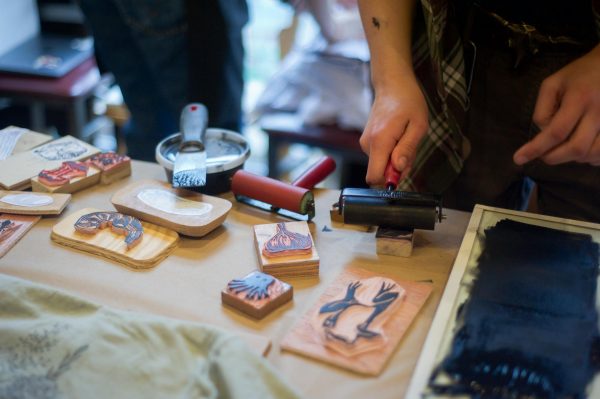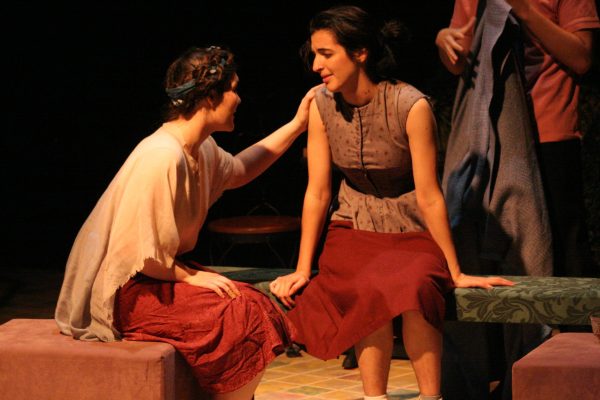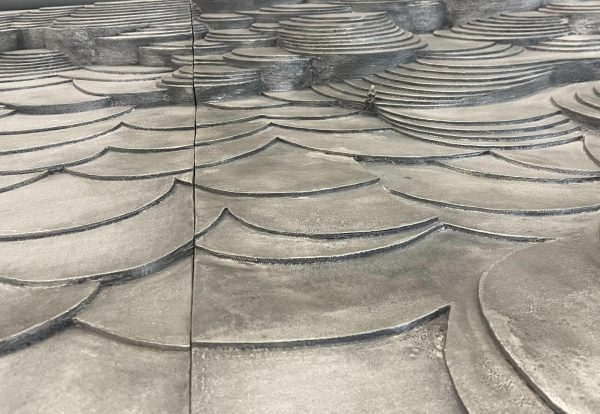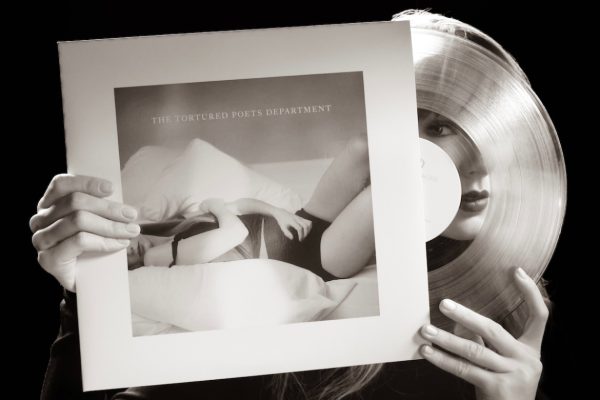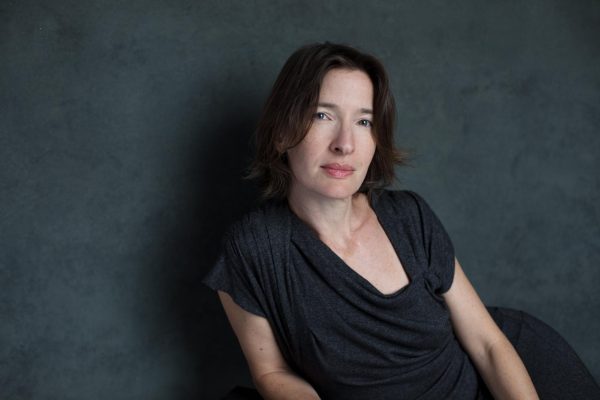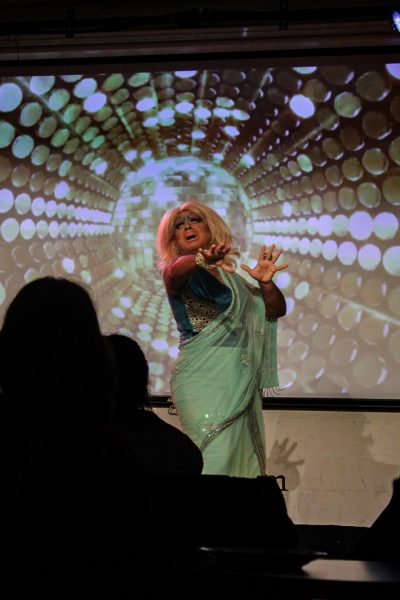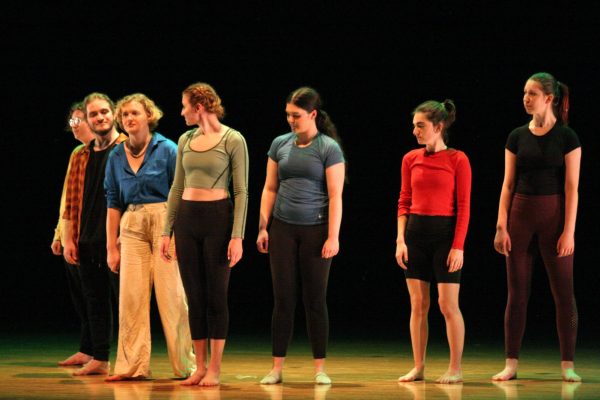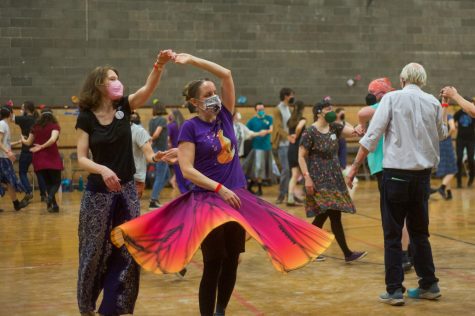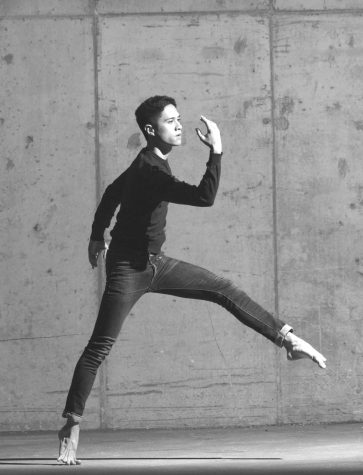Fall Forward Highlights Vulnerability, Dynamism in Student Dance
What comes out of a showcase of auditioned dance works with no theme or specified criteria other than a vision, a faculty advisor, and the ability to be performance-ready by a certain date? Last week, from Nov. 2–4, the 2017 Fall Forward performance featured eight pieces — seven student-choreographed and one by a faculty member — that answered this question with dynamism, variety, artistry, and integrity.
“It was a lovely group of students,” Director and Visiting Assistant Professor of Dance Holly Handman-Lopez said. “It was a delight to sort of shepherd it forward. It was very satisfying to see the growth that happened from auditions to rough run to technology to the performance.”
While the pieces explored diverse ideas with a variety of dance styles and movement vocabularies, all of the works were united by a common thread of vulnerability and exploration.
The show opened with Slip, the first draft of a duet that will be shown in its final iteration in February, choreographed and performed by College senior Kalei Tooman and College sophomore Kierra Nguyen. It is a dramatic window into both the foundations of a relationship, and where it goes from there — as Tooman said, “[The dance] follows two people through the initial moment of contact between two bodies that are unaware of each other and moves until the two people no longer have any interaction with one another.” The movement operates with obsessive, constantly-connected energy despite the dancers rarely touching.
Tension was also actively present in College junior Louise Wurzelbacher’s scratch paper. The dance featured one performer inching along the ground across the upstage for the duration of the piece, wrapped fully in butcher paper in an image reminiscent of Jabba the Hutt. The piece was inspired by a minimalist sculpture (Untitled) by Robert Morris, after Assistant Professor of Dance Alysia Ramos’ choreography class visited the Allen Memorial Art Museum. Six dancers occupied the stage’s foreground, playing with a long strip of butcher paper that was then broken into many sections, allowing for both sequences of individual movement with the paper and interconnected moments, such as when one dancer wrapped the others in the paper and they shoved their arms through it, spinning rapidly. To quote the press release, “This work is an investigation … of the body as a tool for expressions of static and mobile movement within a framed environment.”
College sophomore Buster Coe’s solo work When I Can’t Sleep brought a different energy to the stage, while incorporating the same intimacy as other works through movement and lack of accompanying music.
“Auditioning the piece … was actually very interesting for me,” Coe wrote in an email to the Review. “I had written the dance on my hand because I didn’t know it. The dance faculty loved that I did, so I kept it. It was a happy accident.”
Coe’s movement was both casual and explosive, punctuated by his glances at his hand and the title’s intimate context of a window into someone’s life as they try, and fail, to sleep.
College senior Celia Morris’ Time Signatures created a haunting space using low lighting; an original, live string composition performed by Conservatory junior Aliya Ultan; and focused, circling movement of the pelvis, wrists, and feet. The choreography was inspired by line drawings in a novel, illustrating the creative process.
“Although the lines swooped and cascaded all over the place, they had a very linear arc where they continued moving forward in a semi-contained sphere,” Morris said. “These drawings stuck … which started with the idea of the movement moving horizontally back and forth in a line across the stage, designated by a strip of light. I started building movement by tracing the patterns of the line drawings in space as well as inhabiting the patterns in my body.”
College senior Shai Wolf also explored process in their “quasi-balletic conversation between injury, gender, and existential angst” entitled Corps. The title, Wolf explained, played on the use of the word both to represent dancers in a ballet, and to represent the body. The piece opened with Wolf soloing to Arcade Fire’s “My Body is a Cage,” wearing a chest binder and attached by an ankle to the chair from which they danced. They were then joined onstage by a variety of dancers in whites and greys performing ethereal ballet choreography to the soft music of the band Sleeping At Last, and were eventually coaxed into performing with them. The piece closed with Wolf in the chair again, the lights going down on an image of introspection.
The ultimate message, Wolf said, was that “in facing our limitations and fears by allowing ourselves to be vulnerable, we can remember that we are not alone, and help each other grow by appreciating the expression of our internal turmoil and emotional chaos to find a common humanity.”
College senior Gloria Lewis’ Aw Baby, Dance with Me approached internal turmoil in a different way, intending to celebrate individuality.
Lewis said it was “inspired by the feeling of being the odd one out and yearning for someone’s attention.”
“I was inspired by my own experiences growing up and being a little awkward,” Lewis said. “I wanted this piece to invite the audience to be the person who has to see the Black girl who wants to be celebrated. It’s a happy piece — a celebration that I want people to feel brought into.”
In from Agabatana, College sophomore Kara Nepomuceno explored a duality of meaning in Frank Stella’s “Agbatana III” (from the AMAM): Agbatana was both an ancient Asian city and a word meaning “to lean out a window” in Ilocano, a language from the northern Philippines. This was executed with both classic modernism in dance style and palpable tenderness between her dancers.
“I felt like things really came together during level-set rehearsals when Dan James added lighting to the piece,” Nepomuceno said. “It felt like the sun was moving across the sky, setting just as the dancers finished.”
On Thursday, the show ran a bit longer with a closing performance of Visiting Assistant Professor of Africana Studies and Dance Talise Campbell’s Yanvalou.
“Yanvalou is a traditional piece I created exploring the Fon people of Dahomey, the home of present day Benin in West Africa,” Campbell wrote in an email to the Review. “This is the historical dance of the snake god.”
The piece required deep inquiry into the Fon people and their traditions, she explained, as well as an emphasis on embodying the movements of both water and a snake. It also utilized live performance with both drums and vocals. The dance cast consisted of her students from the class Dance Forms of the African Diaspora and was choreographed in class.
The show was well ordered and dynamic, keeping a pace that engaged the audience with each dance’s particular brand of emotionality and eclectic movement as well as with the performance as a whole. The takeaway was an environment of privacy and intimacy, which we as audience members were privileged to enter and witness.


